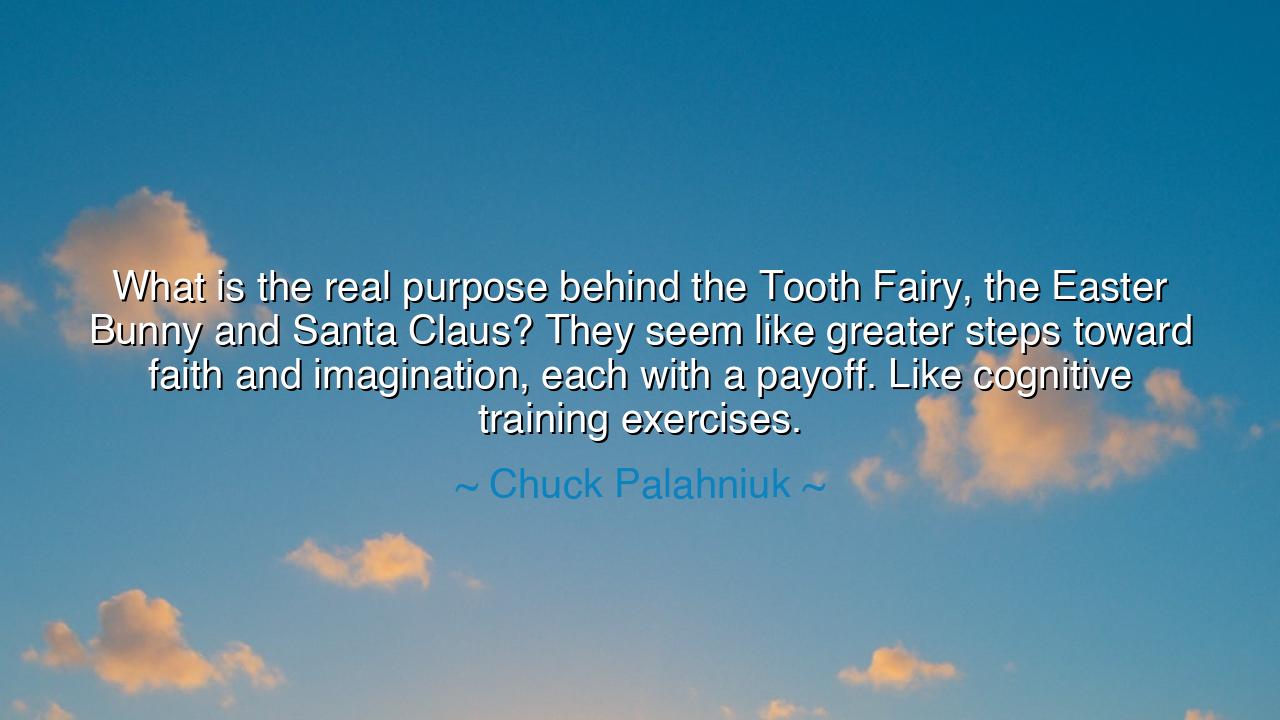
What is the real purpose behind the Tooth Fairy, the Easter Bunny
What is the real purpose behind the Tooth Fairy, the Easter Bunny and Santa Claus? They seem like greater steps toward faith and imagination, each with a payoff. Like cognitive training exercises.






The words of Chuck Palahniuk — “What is the real purpose behind the Tooth Fairy, the Easter Bunny and Santa Claus? They seem like greater steps toward faith and imagination, each with a payoff. Like cognitive training exercises” — reveal a truth that many have forgotten: that myth and wonder are not childish illusions, but sacred tools for the growth of the mind and spirit. Through these playful symbols, humanity teaches its young not merely to believe in magic, but to understand faith, to stretch the wings of imagination, and to prepare for the unseen mysteries of life. In this way, the legends of childhood are not falsehoods — they are the first lessons in perceiving the invisible.
In the ancient world, every culture had its stories that performed this same role. The Greeks told of Hermes who guided souls, the Egyptians of Isis who resurrected Osiris, the Celts of spirits that guarded the hearth. These tales were not about literal truth, but about spiritual rehearsal — the training of the soul to trust what cannot yet be seen. Palahniuk’s insight reminds us that the Tooth Fairy, the Easter Bunny, and Santa Claus are the modern vestiges of that ancient practice. They form a bridge between the child’s innocent logic and the adult’s deeper knowing — that love, hope, and generosity exist beyond the material.
Consider the child who places a tooth beneath their pillow, believing that a small spirit of kindness will come in the night to exchange it for treasure. This act, small as it seems, teaches patience, trust, and the mystery of unseen reward. The Tooth Fairy becomes a symbol of transformation — something lost giving birth to something gained. The Easter Bunny, in turn, brings joy from resurrection, reminding us that life renews itself, that from the tomb of winter springs the green of spring. And Santa Claus, that great giver of gifts, embodies the spirit of selfless generosity, the idea that goodness is rewarded not by transaction, but by love itself.
These myths form the scaffolding of a child’s cognitive training, as Palahniuk calls it. They strengthen the mind’s ability to connect what is unseen with what is real. A child learns that belief can give shape to experience. This capacity to imagine — to hold a vision beyond what the eyes can see — becomes the root of art, science, and morality alike. For what is invention but belief in the possible? What is compassion but faith in the unseen worth of another’s soul? The child who once believed in Santa grows into the adult who believes in justice, in dreams, in a better tomorrow.
There is a story told of Albert Einstein, who once said that “imagination is more important than knowledge.” When asked how he came to such revolutionary ideas about the universe, he said it began in his childhood — with fairy tales. His mother filled his early years not with equations, but with myths and fables, for she knew that the mind must first learn to wander before it can discover. Thus, even in the heart of science, myth had done its holy work. It had trained the mind to see what had never been seen before.
This is the essence of Palahniuk’s reflection: that what we call “make-believe” is not a lie, but a path to faith. The child’s belief in Santa Claus is a rehearsal for the adult’s faith in the goodness of mankind. The trust placed in the Tooth Fairy becomes the trust placed in life itself. The excitement of waiting for the Easter Bunny mirrors the soul’s anticipation for renewal after despair. These stories are rituals of imagination, gentle initiations that awaken the human spirit to wonder and reverence.
Yet, in our modern age, many cast these myths aside too early, calling them foolish or deceitful. But the ancients would have wept at such loss, for they understood that myth is the language of the soul. Without it, the heart becomes mechanical, and the spirit grows barren. To strip a child of wonder is to rob them of the roots of wisdom. For the imaginative mind is the soil from which all virtue grows — faith, empathy, courage, and creation.
So let us not be quick to banish Santa from our hearths or the Easter Bunny from our gardens. Let us instead see them as teachers of imagination, as guardians of wonder, as the gentle architects of belief. The lesson that Palahniuk offers is timeless: nurture the imagination, for it is the foundation of all greatness. Believe, even in the smallest things, for that belief trains the mind to perceive beauty and meaning in the unseen. And when we do this — when we blend innocence with insight — we step once more into the ancient rhythm of the world, where every myth becomes a mirror of truth, and every act of faith becomes a bridge to the divine.






AAdministratorAdministrator
Welcome, honored guests. Please leave a comment, we will respond soon